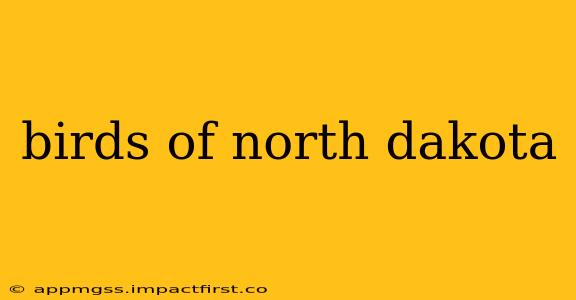North Dakota, with its diverse landscapes ranging from prairies and grasslands to wetlands and forests, boasts a rich avian biodiversity. From majestic eagles soaring overhead to tiny hummingbirds flitting amongst wildflowers, the state is a haven for birdwatchers of all levels. This comprehensive guide explores the fascinating world of North Dakota's birds, covering everything from common species to rare sightings, and answering frequently asked questions about birdwatching in the state.
What are some common birds found in North Dakota?
North Dakota's birdlife is heavily influenced by its geography. Common birds found across the state include:
- Ring-necked Pheasant: The state bird, this iconic pheasant is a common sight in grasslands and agricultural areas. Their vibrant plumage and characteristic calls make them easily identifiable.
- Northern Flicker: This woodpecker is a frequent visitor to backyards and wooded areas, easily recognized by its spotted plumage and distinctive call.
- American Robin: A familiar sight across North America, the American Robin is prevalent in North Dakota, especially during breeding season.
- Red-winged Blackbird: These highly social birds are often found in wetlands and marshes, their distinctive red and yellow shoulder patches making them easily identifiable.
- Brown-headed Cowbird: A brood parasite, the Brown-headed Cowbird lays its eggs in the nests of other birds. This behaviour makes it a fascinating, albeit controversial, subject for birdwatchers.
- Killdeer: These plovers are known for their distinctive, repetitive call and their camouflage, blending seamlessly into their surroundings.
What are the best places to birdwatch in North Dakota?
North Dakota offers a plethora of fantastic birdwatching locations, catering to different preferences and species. Some of the best places include:
- Lake Sakakawea State Park: This expansive park provides diverse habitats, attracting a wide array of waterfowl, shorebirds, and raptors.
- Sheyenne National Grassland: This vast grassland offers excellent opportunities to spot grassland birds, including pheasants, sparrows, and various raptors.
- Pipestem National Wildlife Refuge: A haven for migratory birds, this refuge offers exceptional opportunities to observe a variety of waterfowl and shorebirds.
- Fort Union Trading Post National Historic Site: This site offers a unique blend of history and nature, attracting various bird species that thrive in the diverse habitats surrounding the historic post.
- Theodore Roosevelt National Park: This park's diverse landscape, from badlands to prairies, supports a rich variety of bird species, offering an unforgettable birdwatching experience.
What is the best time of year to birdwatch in North Dakota?
The best time to birdwatch in North Dakota depends on the species you're hoping to see. Spring and fall migrations offer the greatest diversity, with a wide array of birds passing through the state. Summer is a good time to observe breeding birds and their young, while winter offers opportunities to see hardy species that remain throughout the colder months. Each season provides unique opportunities for birdwatching.
What are some rare birds that have been spotted in North Dakota?
While many common species are readily visible, rarer sightings do occur. These can include species that are typically found further south or are simply infrequent visitors to the state. Specific sightings are best tracked through local birding groups and online resources. Consulting eBird or similar platforms can provide up-to-date information on recent rare bird observations in North Dakota.
What are some tips for birdwatching in North Dakota?
- Dress appropriately: North Dakota's weather can be unpredictable, so dressing in layers is essential. Comfortable shoes are crucial for walking across various terrains.
- Bring binoculars: High-quality binoculars are essential for observing birds at a distance.
- Use a field guide: A field guide containing illustrations and descriptions of North Dakota bird species will significantly enhance your birdwatching experience.
- Respect wildlife: Maintain a safe distance from birds and their nests to avoid disturbing them.
- Be patient: Birdwatching requires patience. Allow ample time to observe and appreciate the birds you encounter.
- Join a birding group: Connecting with local birding groups provides valuable insights, opportunities for guided tours, and companionship.
This guide provides a starting point for exploring the wonderful world of birds in North Dakota. With its diverse landscapes and abundant avian life, North Dakota offers incredible opportunities for birdwatching enthusiasts of all skill levels. Remember to always practice responsible and ethical birdwatching techniques to protect these magnificent creatures and their habitats for generations to come.
